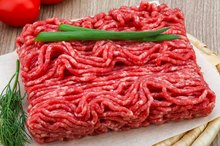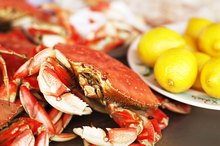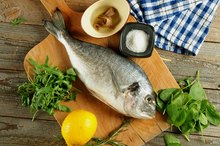What does fact checked mean?
At Healthfully, we strive to deliver objective content that is accurate and up-to-date. Our team periodically reviews articles in order to ensure content quality. The sources cited below consist of evidence from peer-reviewed journals, prominent medical organizations, academic associations, and government data.
- National Institutes of Health Office of Dietary Supplements: B-12
- Linus Pauling Institute: Copper
- MedlinePlus.com: Zinc
The information contained on this site is for informational purposes only, and should not be used as a substitute for the advice of a professional health care provider. Please check with the appropriate physician regarding health questions and concerns. Although we strive to deliver accurate and up-to-date information, no guarantee to that effect is made.
The Nutrition in Steamed Crabs
Crabs are a type of crustacean, meaning they have a hard exoskeleton and no inner skeleton -- like insects. Although there are several different species of crabs, dungeness and blues are popular choices for steaming. Much of the crab is inedible -- a 7-ounce crab may yield less than 3 ounces of meat. In general, male crabs are larger and meatier than females and are more desirable for steaming.
Tips
One serving of Steamed Crabs is reported to have 630 Calories, according to the nutrition facts provided by livestrong.com.
Nutritional Overview
Steamed crabs contain protein and fat but no carbohydrates. Three ounces of steamed crab meat contains 87 calories, 17 grams of protein and about 1 gram of fat. The majority of fat -- 0.6 grams -- is polyunsaturated; 0.2 g is monounsaturated and 0.2 grams is saturated fat. In other words, 83 percent of crab meat is protein and 17 percent is fat. Like all saltwater seafood, there is some naturally occurring sodium -- about 235 milligrams -- more than 10 percent of the USDA recommended sodium intake for the general population -- 2,300 milligrams.
- Steamed crabs contain protein and fat but no carbohydrates.
- The majority of fat -- 0.6 grams -- is polyunsaturated; 0.2 g is monounsaturated and 0.2 grams is saturated fat.
Vitamin B-12
Lean Meat and Fatty Meat
Learn More
Steamed crabs are an excellent source of vitamin B-12; just 3 ounces of crab meat contains more than 100 percent of your RDA of B-12, which your body uses to produce red blood cells and DNA synthesis. Adequate B-12 intake may help prevent heart disease, cognitive and age-related brain decline and boost your energy levels, according to the National Institutes of Health 4. A B-12 deficiency can cause neurological disorders.
Mineral Content
A 3-ounce serving of crab meat also contains 27 percent of your RDA of copper and 24 percent of zinc. Copper performs several roles in the body, including energy production, iron metabolism and the formation of connective tissues, according to the Linus Pauling Institute 5. Copper may also help boost your immune system and prevent osteoporosis, Alzheimer's and Parkinson's disease. Zinc is also important in keeping your immune system strong and may reduce the severity and duration of the common cold, according to MedlinePlus.com 6. Other benefits of zinc include reducing your risk of macular degeneration, ostoporosis, stomach ulcers and muscle cramps.
A Dozen Steamed Crabs
Sea Scallop Nutrition
Learn More
Generally when ordering steamed crabs, you order by the dozen or the bushel. A dozen crabs is always 12, but the number in a bushel varies depending on crab size. Twelve large crabs -- about 7 ounces each -- should provide 630 calories, 125 grams of protein and 11 grams of fat. Unfortunately, they will also provide more than twice the recommended amount of dietary cholesterol -- 618 milligrams -- and 150 percent the recommended amount of sodium -- more than 3,700 milligrams.
- Generally when ordering steamed crabs, you order by the dozen or the bushel.
- A dozen crabs is always 12, but the number in a bushel varies depending on crab size.
Choosing Crabs
Crabs are divided into five size categories, but category standards change based on the region. The categories -- small, medium, large, jumbo and colossal -- are based on size measurement across the body, not weight. Male crabs are called "jimmies" and female crabs are called "sooks." Jimmies have more meat and are preferred for steaming. When buying live crabs, ask for heavy or fat crabs, which are near the end of their molting period 3. Crabs that have just molted will be full of water and not meaty.
- Crabs are divided into five size categories, but category standards change based on the region.
Related Articles
References
- Blue Crab: Nutrition Facts
- USDA Nutritional Database: Crustaceans, Crab, Blue, Cooked, Moist Heat
- Blue Crab: Buying Hard Crabs
- National Institutes of Health Office of Dietary Supplements: B-12
- Linus Pauling Institute: Copper
- MedlinePlus.com: Zinc
- Centers for Disease Control and Prevention. Pubic "Crab" Lice: Frequently Asked Questions. Atlanta, Georgia; updated September 26, 2019.
- Centers for Disease Control and Prevention. Lindane. Atlanta, Georgia; updated December 4, 2014.
- U.S. Food and Drug Administration. Medication Guide; Lindane (LIHN-dane) Shampoo, USP 1%. Silver Spring, Maryland; August 2007.
- Karabela Y, Yardimci G, Yildirim I, et al. Treatment of Phthiriasis Palpebrarum and Crab Louse: Petrolatum Jelly and 1% Permethrin Shampoo. Case Rep Med. 2015;2015:Article ID 287906. doi:10.1155/2015/287906
- Salavastru CM, Chosidow O, Janier M, Tiplica GS. European guideline for the management of pediculosis pubis. J Eur Acad Dermatol Venearol. 2017 Sep;31(9):1425-8. doi:10.1111/jdv.14420
Writer Bio
Maura Shenker is a certified holistic nutritionist and health counselor who started her writing career in 2010. She leads group workshops, counsels individual clients and blogs about diet and lifestyle choices. She holds a Bachelor of Fine Arts from the Rhode Island School of Design, a Master of Fine Arts from The Ohio State University and is a graduate of the Institute for Integrative Nutrition.









